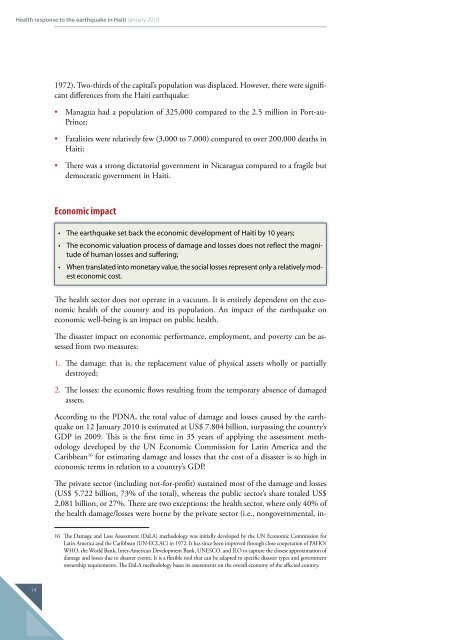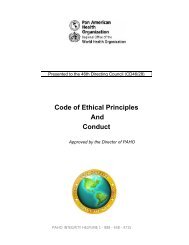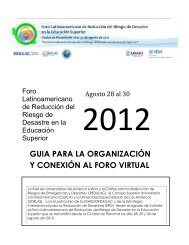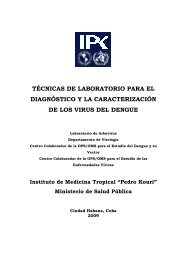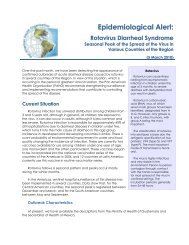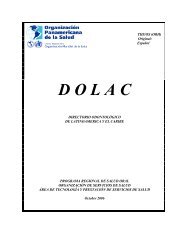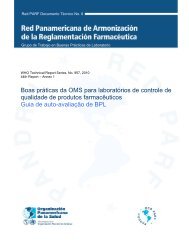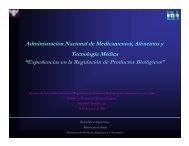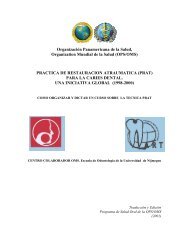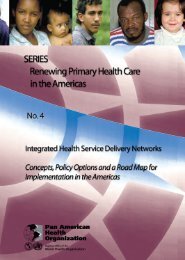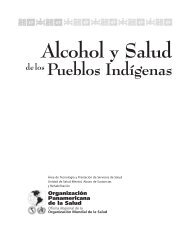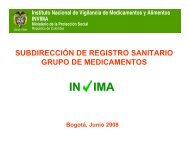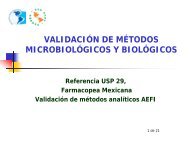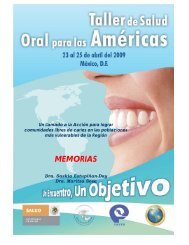Health response to the earthquake in Haiti, January 2010
Health response to the earthquake in Haiti, January 2010
Health response to the earthquake in Haiti, January 2010
- No tags were found...
You also want an ePaper? Increase the reach of your titles
YUMPU automatically turns print PDFs into web optimized ePapers that Google loves.
<strong>Health</strong> <strong>response</strong> <strong>to</strong> <strong>the</strong> <strong>earthquake</strong> <strong>in</strong> <strong>Haiti</strong> <strong>January</strong> <strong>2010</strong>1972). Two-thirds of <strong>the</strong> capital’s population was displaced. However, <strong>the</strong>re were significantdifferences from <strong>the</strong> <strong>Haiti</strong> <strong>earthquake</strong>:• Managua had a population of 325,000 compared <strong>to</strong> <strong>the</strong> 2.5 million <strong>in</strong> Port-au-Pr<strong>in</strong>ce;• Fatalities were relatively few (3,000 <strong>to</strong> 7,000) compared <strong>to</strong> over 200,000 deaths <strong>in</strong><strong>Haiti</strong>;• There was a strong dicta<strong>to</strong>rial government <strong>in</strong> Nicaragua compared <strong>to</strong> a fragile butdemocratic government <strong>in</strong> <strong>Haiti</strong>.Economic impact• The <strong>earthquake</strong> set back <strong>the</strong> economic development of <strong>Haiti</strong> by 10 years;• The economic valuation process of damage and losses does not reflect <strong>the</strong> magnitudeof human losses and suffer<strong>in</strong>g;• When translated <strong>in</strong><strong>to</strong> monetary value, <strong>the</strong> social losses represent only a relatively modesteconomic cost.The health sec<strong>to</strong>r does not operate <strong>in</strong> a vacuum. It is entirely dependent on <strong>the</strong> economichealth of <strong>the</strong> country and its population. An impact of <strong>the</strong> <strong>earthquake</strong> oneconomic well-be<strong>in</strong>g is an impact on public health.The disaster impact on economic performance, employment, and poverty can be assessedfrom two measures:1. The damage: that is, <strong>the</strong> replacement value of physical assets wholly or partiallydestroyed;2. The losses: <strong>the</strong> economic flows result<strong>in</strong>g from <strong>the</strong> temporary absence of damagedassets.Accord<strong>in</strong>g <strong>to</strong> <strong>the</strong> PDNA, <strong>the</strong> <strong>to</strong>tal value of damage and losses caused by <strong>the</strong> <strong>earthquake</strong>on 12 <strong>January</strong> <strong>2010</strong> is estimated at US$ 7.804 billion, surpass<strong>in</strong>g <strong>the</strong> country’sGDP <strong>in</strong> 2009. This is <strong>the</strong> first time <strong>in</strong> 35 years of apply<strong>in</strong>g <strong>the</strong> assessment methodologydeveloped by <strong>the</strong> UN Economic Commission for Lat<strong>in</strong> America and <strong>the</strong>Caribbean 16 for estimat<strong>in</strong>g damage and losses that <strong>the</strong> cost of a disaster is so high <strong>in</strong>economic terms <strong>in</strong> relation <strong>to</strong> a country’s GDP.The private sec<strong>to</strong>r (<strong>in</strong>clud<strong>in</strong>g not-for-profit) susta<strong>in</strong>ed most of <strong>the</strong> damage and losses(US$ 5.722 billion, 73% of <strong>the</strong> <strong>to</strong>tal), whereas <strong>the</strong> public sec<strong>to</strong>r’s share <strong>to</strong>taled US$2.081 billion, or 27%. There are two exceptions: <strong>the</strong> health sec<strong>to</strong>r, where only 40% of<strong>the</strong> health damage/losses were borne by <strong>the</strong> private sec<strong>to</strong>r (i.e., nongovernmental, <strong>in</strong>-16 The Damage and Loss Assessment (DaLA) methodology was <strong>in</strong>itially developed by <strong>the</strong> UN Economic Commission forLat<strong>in</strong> America and <strong>the</strong> Caribbean (UN-ECLAC) <strong>in</strong> 1972. It has s<strong>in</strong>ce been improved through close cooperation of PAHO/WHO, <strong>the</strong> World Bank, Inter-American Development Bank, UNESCO, and ILO <strong>to</strong> capture <strong>the</strong> closest approximation ofdamage and losses due <strong>to</strong> disaster events. It is a flexible <strong>to</strong>ol that can be adapted <strong>to</strong> specific disaster types and governmen<strong>to</strong>wnership requirements. The DaLA methodology bases its assessments on <strong>the</strong> overall economy of <strong>the</strong> affected country.14


